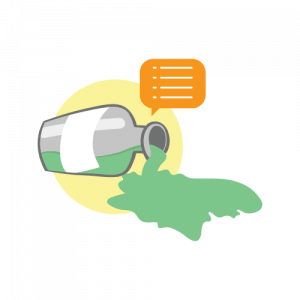- Chemical Spill Characteristics
- What To Do
- Spill Notification Procedure
- Simple Compressed Gas Leak
- Biohazardous Spill
- Radioactive Spill
- Resources
Chemical Spill Characteristics
How a chemical spill is handled is dependent on its size, associated hazards of the released material(s), available resources, and the experience/competence level of the laboratory personnel/responder. Use the table below to differentiate between a minor and major chemical spill.
Minor Chemical Spill |
Major Chemical Spill* |
|
|
*Note: Lab personnel should NOT attempt to clean up a major chemical spill.
What to Do
- DO NOT attempt to clean a spill beyond your level of comfort or expertise. When in doubt, call DPS.
- For MINOR spills, ensure that clean-up materials are compatible with spilled materials. A spill kit can be assembled by the laboratory, or a commercial kit can be purchased from a laboratory supply company.
- All laboratory personnel must be familiar with the spill kit storage location and use of the spill kit. If the spill kit is not conspicuously located (e.g., a storage cabinet), then post signage marking its location.
- Follow the protocols provided by USC EH&S, Safety Data Sheet (SDS), or by the manufacturer of a professional spill kit to clean up a minor chemical spill; see the Chemical Spill Kit Guide Sheet for more information.
Note: Additional spill kit materials and guidance for work with HF, Phenol and Mercury is detailed in the CHP.
Chemical Spill Notification Procedure
Follow the steps below for hazardous spills (see Chemical Spill Notification flyer).
- Alert all persons nearby.
- Secure the area and DO NOT attempt to clean unless you are properly trained, equipped, and you understand the chemical/hazardous characteristics of the spilled material.
- Evacuate, if necessary.
- Call DPS- UPC: (213) 740-4321; HSC: (323) 442-1000. Notify DPS of any spill, even if the spill was cleaned.
Simple Compressed Gas Leak
In the event of a non-toxic and non-flammable (e.g. argon, air, nitrogen, oxygen) compressed gas leak, follow the steps outlined below.
- For a catastrophic release of gas, immediately evacuate the lab, close the door, and call DPS.
- For a slow release of gas:
- Restrict access.
- Locate the leak by listening for a hissing sound or by applying soapy water to gas cylinder connections, if needed.
- If the cylinder or cylinder valve is leaking, immediately contact the supplier.
- Do NOT attempt to repair the cylinder or the valve.
- Label the cylinder as “Defective.”
- If the regulator is leaking, immediately discontinue use and send the regulator back to the manufacturer for repair or replace with a new regulator.
- Faulty or improperly repaired regulators are a serious hazard.
- Do NOT attempt to disassemble or repair regulators.
- If the pipework valves or equipment are leaking, repair, replace, or tighten fittings, as appropriate.
- Do not make any changes without approval from supervisors.
- Perform leak testing before returning cylinder to service.
Biohazardous Spill
Follow instructions in the Biohazardous Spill Clean-Up Guide Sheet for minor biohazardous spills. For major biohazardous spills, notify DPS. Contact Biosafety at biosafety@usc.edu for additional information.
Radioactive Spill
Follow instructions in the Radiation Emergency Procedures to clean up minor and major radioactive spills. Contact Radiation Safety at radsafety@usc.edu for additional information.
